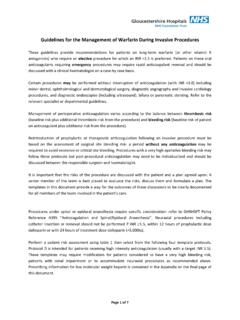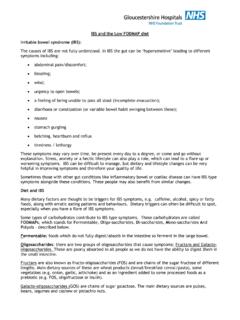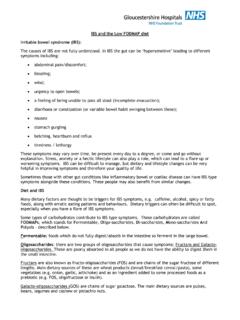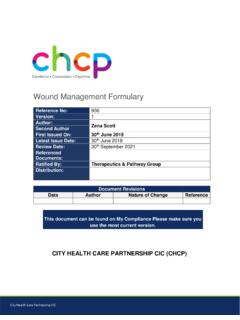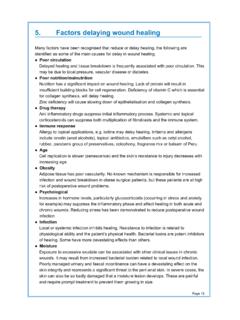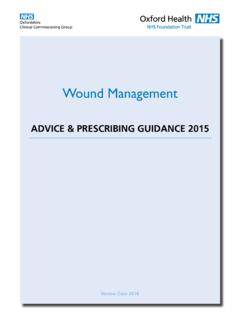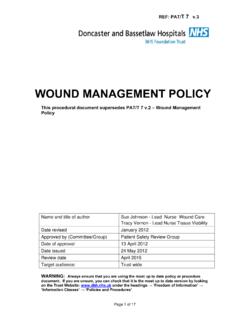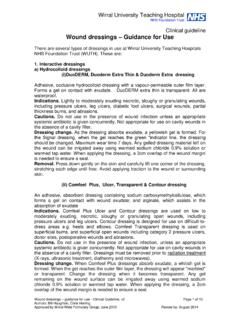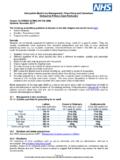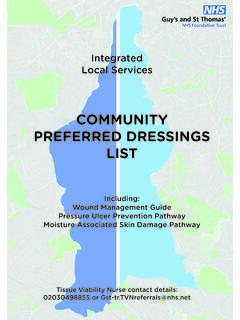Transcription of Wound Management Formulary
1 The Wound Care Formulary was compiled by representatives from Gloucestershire Hospitals NHS Foundation Trust, Gloucestershire Care Services NHS Trust, Together NHS Foundation Trust and the Gloucestershire Clinical Commissioning Group. It was a multidisciplinary group made up of registered nurses (including tissue viability specialist nurses), podiatrists, financial accountants as well as procurement and administrative support team members. Advice was given to the group by pharmacists working at the Gloucestershire Clinical Commissioning Wound Management Formulary 2019 Reviewed 2019 Next routine review 2021 IntroductionAlert symbol to indicate product is expensiveStop and consider if a lower cost product would achieve an equivalent symbol to indicate product is a high spend item. In 2018/19 the highest spend was on barrier creams, foam dressings, protease modulating matrix dressings and soft polymer waste goal is to assess the Wound correctly, use the right dressing, at the right time, flag an alert to important clinical PageWOUND CARE FORMULARY1.
2 Skin care and barrier Barrier Skin wash2. Basic Wound contact Low adherence Absorbent Absorbent Super absorbent Adhesive dressing with pad3. Advanced Wound Hydrogel Vapour permeable Hydrocolloid dressings Hydrofibre Foam Non adhesive Foams with adhesive without Foams with silicone Polyurethane foam film Alginate dressings Odour absorbent dressings4. Antimicrobial Honey Iodine Silver Enzyme alginogel DACC (dialkylcarbamoyl chloride) dressings5. Specialised Protease-modulating matrix dressings6. Adjunct dressings and Physical Debridement Fludroxycortide tape and Pressure reducing Wound irrigation/cleaning Adhesive Remover7. Complex adjunct Topical negative pressure therapy8. Wound care Dressing Woven and fabric Surgical adhesive Adhesive dressings9 Light weight conforming Elasticated tubular bandages Sub-compression Short stretch conforming bandages Compression Two layer compression Multi-layer compression Medicated bandagesIntroductionThis Formulary is a revised edition for 2019.
3 It is based on the previous Formulary , which was developed by The County Wide Tissue Viability Steering Group comprising of representatives from Gloucestershire Care Services (GCS) and Gloucester Hospitals NHS Foundation Trust. This Formulary has been reviewed by multidisciplinary professionals representing all Gloucestershire Health aims are towards: Promoting evidence based practice by providing a framework within which it is safe to practice. Promoting continuity of care. Promoting rational prescribing. Supporting the practical application of nurse prescribing. Encouraging safe, effective and appropriate use of dressings. Cost effectiveness. This Formulary is aimed at aiding clinical staff to select the most appropriate dressing for wounds healing by secondary intention. Dressing selection is only a small part of Management of a patient with a Wound . Prior to selecting a dressing for a Wound there should be an assessment of the general health of the patient as this is critical to enable effective planning and evaluation of the care provided.
4 A holistic assessment should include:Medical historyCause of woundLong Term ConditionsNutritional intakeMorbiditySupport from carers/relativesPsychological factorsLifestyle factorsPatient s ageMedication (over the counter and recreational use)Smoking AllergiesA Wound assessment should take place which includes: Wound typeLocation, grade if pressure ulcerationSizeClassification of Wound bedExudate colour and amountOdour Pain Surrounding skinClinical signs of infection /critical colonisationThese Formulary choices are based on performance and stability of both the item and the manufacturing / supplying company, as well as consideration of order the exact amount of dressings required, and not necessarily the listed pack size. Supplier details and contact numbers can also be obtained from the BNF. Multi Compression bandaging should be ordered following your current Trust and external policies and procedures that are relevant to this Formulary include: Gloucestershire Care Services NHS Trust POPAM (Policy on ordering, Prescribing and Administering Medicines) Nursing Procedures The Royal Marsden Manual of Clinical nursing Procedure 9th Nurse Order form is available to use when requesting FP10 supplyIt is anticipated that this Wound Formulary will be suitable for the vast majority of wounds and we expect that there will be a 100% compliance with the Formulary if there is not suitable product for the Wound please report using an exception reporting a non- Formulary product is used, a Non- Formulary Exception Reporting Form (available as Appendix 1) must be completed and returned to.
5 The Lead Tissue Viability Nurse, Gloucestershire Care Services, Edward Jenner Court, Pioneer Avenue, Gloucester Business Park, Brockworth, Gloucester, GL3 non- Formulary products are identified repeatedly, we can consider revising the Formulary . Your feedback is important. Always follow manufacturer s guidelines when applying line: Available to all practitioners undertaking Wound care. Go . Good choice, this will help you make Line: Available after consultation with a specialist nurse or tissue viability nurse. Consider Could you use a less expensive item?Hospital or one of the following specialist services only podiatry, Complex Leg Wound Service, Lymphoedema and Tissue Viability. Think Please use this high cost item with care. Could a less expensive product do the same job!New products and Review of the FormularyThe Formulary is completely updated once every two years but some changes to the dressings available on the template will occur annually. The changes will reflect current best products can be proposed to the Wound Care Formulary Group for review.
6 The product will then be screened by the review group and if agreed trialled and evaluated. If recommended by the Wound Formulary Group it will be added to the Formulary when it is refreshed annually in SamplesManufacturers sales representatives often offer staff members samples of dressings. Samples should not be used to treat NHS patients and all offers should be is fundamental that dressings with active pharmaceutical products are not mixed, iodine and will alter the pharmaceutical property of the product and the practitioner will not know the exact pharmaceutical product they are putting on the Wound Care Formulary : 1 SKIN CARE AND BARRIER Barrier CreamsThey are used on the skin around stomas, pressure ulcers and pressure areas in the elderly when the skin is intact. When the skin has broken down, barrier creams have a limited role in protecting adjacent skin. Barrier creams are not a substitute for good nursing. For relief of pressure see Pressure Relief Pathway.
7 Barrier creams are used as treatment in the Skin Care Protocol, Moisture Associated Skin Damage Pathway, Skin Tear Pathway, the Leaky Legs (Wet Legs) Pathway and Exudate 2018/19 over 500,000 was spent on barrier creams in Gloucestershire. They are the item with the highest spend in the Wound Care Formulary . When prescribing for treating a medical conditions please consider if the most approariate product has been selected. Provide adequate information so it is used correctly. For healthy/intact skin advise patients to use their usual washing lotions and moisturing creams. Patients in their own home or a care home should have skin care products supplied by the patient, their family or the care Barrier CreamThornton & Ross28g = = with healthy/intact skin should be advised to buy their own barrier cream when used in their own home or a care home. See items for personal manufacturer states their product is similar in formulation to Cavilon Durable Barrier Cream.
8 Cavilon Durable Barrier Cream Purple 3M28g = = manufacturer states the product can be used on intact and broken skin. Prevent wasteLasts for 72 skin feels oily it is an indication too much cream is being sachet2g sachet for hospital use Barrier Film with applicator Lollipop 3M1ml x5 = x 25 = ( each)Lasts for 72 hours Prescribe for two weeks and reassess need to continue script. Measures to ensure the continued drying of the skin fold must be a primary treatment be used to protect peri- Wound for VAC dressings and adhesive dressingsPrevent if this product is required? Would a barrier cream be sufficient?Is an applicator necessary or can use a cheaper alternative without an applicator?Contents pageMedihoney barrier creamMedihoney50g =- around infected wounds including wounds known to be MRSA only one tube and review before further prescription is requested. Once skin is healed revert to a lower cost product see skin care pathway.
9 If at re-assessment skin is not healing as anticipated refer to Tissue Viability Nursing sachetHospitals onlyFoam & Spray CleanserVernacare150ml = 200ml = as part of the Moisture Associated Skin Damage PathwayPrescribe once and review before repeating script. If skin is not healing refer patient to Tissue Viability manufacture advises to use with a skin wipe. These should be purchased as an Over The Counter product and not routinely prescribed on a Skin wash and cleansing foamA wash should only be prescribed for a patient on a skin pathway. ProductManufacturerSizeTipsSunset Skin Cleansing Foam Vernacare150ml spray = spray = spray = Skin Cleansing Foam gently lifts soiling, whilst cleansing, restoring and moisturising the skin. Discontinue use if any irritation one container of cleanser. Review skin before re-ordering. When skin healed step down to soap and manufacture advises to use with a skin wipe. These should be purchased as an Over The Counter product.
10 Available at supermarkets. Wipes are not routinely prescribed on a s guide to using the wash lotionSch lke 150ml bottle =- bottle =- as a body and hair wash. It contains octenidine, a broad-spectrum antimicrobial agent. It is used as part of the suppression therapy for MRSA 5 day card Octenisan no day care Octenisan Patient LeafletDermol 500 (liquid)Dermal Laboratory Ltd500ml = to the skin or used as a substitute for Care Protocol Used in the hospital to clean severely macerated skinLeaky Legs Pathway Used as a wash at dressing changes2 BASIC Wound CONTACT Non/Low Adherence Wound Contact Dressings: Wound contact layers comprise a single layer of non-adherent mesh-like material designed as protection for fragile tissue on the Wound bed. They are usually used in the early, proliferative stages of healing to promote granulation and epithelialisation. They can be used as the first line dressing when treating simple venous ulcers alongside compression TouchKCI5cm x 7cm = x 15cm = x10cm = x 32cm = soft silicone Wound contact dressingSometimes needed as an occlusion dressing with Topical Negative Pressure Tear Pathway Used on skin tear pathway for wounds which are wet or SilnetB Braun Medical Limited5cm x = x 10cm = x 18cm = x 30cm = silicone-coated Wound contact Absorbent Dressings Absorbent padProductManufacturerSizeTipsZetuvit PlusHartman10cm x 10cm = x 20cm = x 20cm = x 40cm = absorbent dressing padLeaky (Wet) Legs Pathway Product used in the Leaky Legs pathway Skin Tear Pathway Use absorbent pad over Adaptic Touch following a skin tear which is wet or with a Super absorbent padSuperabsorbent dressings have extra fluid-handling capacity.

